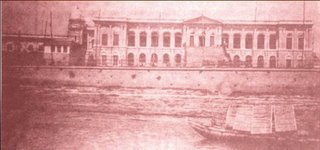
Ahsan Manzil without dome on the bank of Buriganga River in 1880


Palace severely damaged by tornado in 1888

Reconstructed palace with dome by Nawab family


After Estate aquisition by government, palace dilapidated and under unauthorized occupation of squatters

Restoration of Ahsan Manzil by Govt (PWD) in late 80's and completion by '92.

Restorated Ahsan Manzil turned to National Museum Authority
(pic credit: unknown website)
Situated at Kumartoli of Dhaka on the north bank of the Buriganga, this was the residential palace and the kachari of the Nawabs of Dhaka, and is one of the most significant architectural monuments of Bangladesh. Construction of this palace began in 1859 by Nawab Abdul Ghani and was completed in 1872. He named it ‘Ahsan Manzil’ after his son Khwaja Ahsanullah.
Established on a raised platform of 1 metre, the two-storied palace measures 125.4m x 28.75m. The height of the ground floor is 5 m and that of the first floor is 5.8 m. The octagonal metal dome is 27.13 m high from the ground. There are porticos both on the northern and southern sides. An open spacious stairway comes down from the southern portico, extending onto the bank of the river through the front garden. Internally, the palace is divided into two symmetrical halves on either side of the dome. There is a large drawing room in the east wing of the first floor. On the ground floor there is a big dining hall and six square rooms in the eastern part. In the western side, there is a gigantic durbar hall and to its north is a billiard room. There was once a fountain in the garden in front of the stairs, which does not exist today. The verandahs and rooms are covered with marble. In 1874, Lord Northbrook, Governor General of India attended an evening function here, when he came to lay the foundation for water works installed by Nawab Abdul Ghani. In 1888, Lord Dufferin, and in 1904, Lord Curzon on a visit to East Bengal, stayed in this palace on 18-19 February to win public support for the proposed Partition of Bengal.
Dating back to the late 19th century, the Nawab Family played an important role in the freedom movement and politics of the Indian subcontinent. Almost all political activities of Nawab Khwaja Sallimullah centered round this palace. Ahsan Manzil was the cradle of the All India Muslim League. On April 7, 1888, a tornado caused severe damage to the palace. An earthquake once again damaged it in 12 June 1897. With the decline of the fortunes of Nawab of Dhaka, the condition of palace also started to decline. In 1952 Govt under the Estate Acquisition Act acquired the Dhaka Nawab Estate. It became impossible for the successors of Nawabs to maintain the palace due to financial constraints. The palace was on the verge of collapse. Over the years, illegal occupants turned the place into a filthy slum. Recognizing the historical and architectural importance of the Ahsan Manzil, Govt. took initiative to repair and renovate it to its original shape. Ahsan Manzil and its surroundings were acquired in 1985 and renovation work was completed in 1992. It has been brought under the control of National Museum and a museum has been established there.

2 comments:
UWeQdX The best blog you have!
W19BvP write more, thanks.
Post a Comment